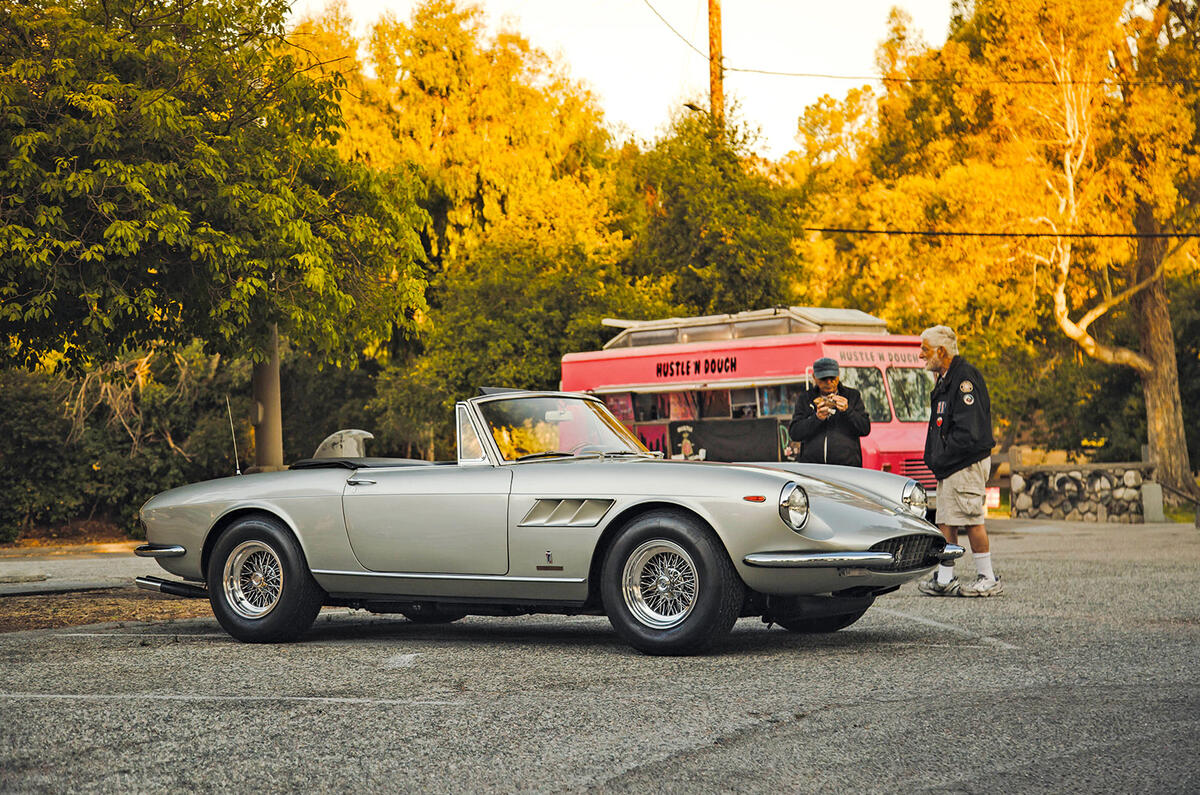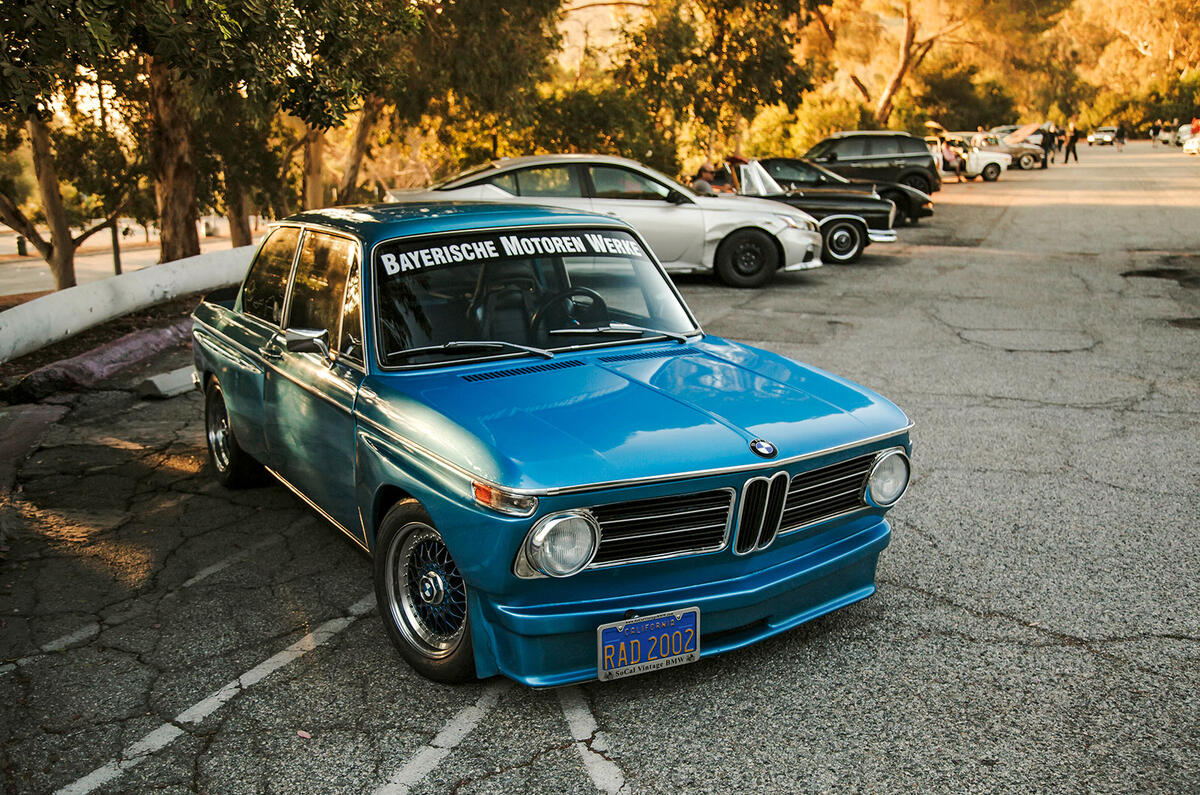I am standing in a quiet, shady car park on the northern edge of Los Angeles and a Citroën BX on UK numberplates is floating through a car park before me.
This is the aptly named Cars and Coffee Los Angeles, a fairly low-key event that takes place in the foothills of the Santa Monica mountains that tower above Downtown LA.
From 7am until 10am on the last Sunday of every month, a sleepy car park on the site of the original Los Angeles Zoo is transformed into a petrolhead’s paradise.
At least, that’s what I’ve been told. But it’s currently 6.55am and my Uber driver has dropped me off in a large, depressingly empty car park. I sit for a minute or so, working out my next move.
Then I hear the unmistakable sound of a straight six gently echoing up the valley, high-pitched notes caught on the cool breeze.
Moments later, a shark-nose BMW 635 CSI glides into view, its Paul Bracq-designed silhouette recognisable from 100 metres away. It cruises past, heading down a side road I hadn’t noticed before.
Naturally, I follow and am soon passed by an impossibly long Mercedes W112 Cabriolet and a similarly aged Chevrolet pick-up truck that appears to be the size of a small house.
What they lead me to is the motoring equivalent of El Dorado. The clock’s only just gone seven but this car park, hidden in the trees, is filling up fast.
In the middle are a group of off-roaders, comprising a few classic Ford Broncos and a couple of clearly European-spec Land Rover Defenders, one still featuring its original Spanish numberplate on the front.
They sit side by side with an incredibly clean 964-gen Porsche 911, a black Ferrari Mondial and a roofless Ford Model A hot rod, all looking resplendent in the morning sun. There’s something about the slight smoggy haze in LA that makes cars look even better than they do normally.
Rejuvenated by coffee truck supplies, I ponder the origins of this type of event. People have been getting together to show each other their rides since the second car was built, but car culture was cultivated in California a bit more than it was in most other places – partly down to the warm climate, partly because of the fabulous roads.
A modern Cars and Coffee event is characterised by a lack of formality. There’s no invited guest list and no big promotion beforehand: you simply tell a few people who you think might be interested and people show up on a Sunday morning.
Some say that this modern format was popularised in the early 2000s by Barry Meguiar (you’ve almost certainly heard of his car cleaning products), who started a laid-back event at a place called Crystal Cove, just south of LA.
Before he knew it, the event had grown larger and larger, prompting a move to Ford’s Irvine design studio. Officially known as Cars and Coffee, it proved to be a massive hit, with copycats springing up all over the place.
This particular one was started in 2017 with the aim of bringing together LA-based enthusiasts and it took place in a few different locations around the city before settling on Griffith Park.
It stays true to the laid-back ethos, with the online page for the event calling it “very chill”.
There’s possibly no better way to sum it up than that. Everyone wants to talk about their cars, but they’re preoccupied with looking at what else has turned up.
The cars rolling through the entrance are varied in a way that we would just never see in the UK – a Ferrari Testarossa is followed in by a V8-swapped Datsun 240Z, while a Peugeot 405 Mi16 parks up opposite a Ford Explorer decked out in full Jurassic Park livery, complete with a speaker playing dinosaur roars.
Everything gets attention, whether it’s a Lamborghini Gallardo Spyder (few cars have aged better) or a Ford Ranchero pick-up truck.
“This couldn’t happen anywhere else,” the 405’s owner tells me. “Everyone is so laid-back, the weather helps keep cars pristine and people are so happy to bring their cars out.”
Three hours have passed in the blink of an eye and I have a flight to catch. As I await my Uber, watching cars leave the car park sensibly (crucial to keeping the event running), a Renault Dauphine that makes a GT3 car look tame rolls by, followed by a Nissan 350Z that looks like something out of a cyberpunk megacity.
Forget Hollywood: these are the real stars of LA.
Dodge Power Wagon

Just shy of 440bhp and four-wheel drive sounds like an exciting recipe, doesn’t it? This highly sought-after Sweptline-era truck (named for that swoosh down the side of the load bay) was what passed as a utility pick-up back in the late 1960s, and this one has been freshly rebuilt.
The suitably cowboy-hatted owner reckons that the new engine - which has less than 1000 miles on the clock - is now pumping out close to 500bhp. Tasty.
Subaru GL

You might remember the Subaru BRAT pick-up, but do you remember that it was just a small part of the wider Subaru Leone family?
This is an immaculate example of a GL hatch, with a 1.8-litre flat-four engine sending a whopping 73 horsepower to all four wheels if so desired by the driver, with high and low range on offer.
Citroen BX 14

A left-field choice that manages to look right at home in the Golden State, the BX was one of Citroën’s finest hours. Hydrogas suspension helps the beautiful Marcello Gandini-designed body float along the road, being propelled by a 1.4-litre engine.
This one has led a full life, going first from France to the UK and then to LA earlier this year.
Renault Dauphine

Few remember that Renault’s diminutive Dauphine sold well in the States, being one of the most popular imported cars of its time. This one was bought, sold and forgotten about, rusting in a Californian desert for almost 50 years.
The current owner rescued it and has lightly modified it, extending the wings, fitting dampers from a Yamaha R1 superbike and Nascar-spec anti-roll bars, and installing a 240bhp VR6 engine from a VW Golf. Sorry, did I say lightly modified?
Volkswagen Squareback

The Squareback was born to bridge the gap between the Beetle and the Type 2 van while keeping VW’s signature features, such as an air-cooled rear engine.
This one doesn’t have that. Instead, there’s a Corvette-sourced LS V8 under the front bonnet, with the chassis of the car having been modified to accommodate the 5.7-litre lump and rear-wheel drive. You can keep your Audi RS6s: this is a real sleeper.
Ferrari 330

If the 1960s were a high point in car design, then the Ferrari 330 is a high point of the 1960s.
Designed by the legendary Pininfarina as a replacement for the 275 GTB, it featured independent rear suspension for the first time in a Ferrari, which made it easier to use all 300bhp produced by the 3.0-litre Colombo V12 crammed under the bonnet.
They built only 99 GTS convertibles – and this one sits alongside a 1952 Alvis and a Shelby Series 1 in the owner’s garage.
Ford Galaxie 427 Lightweight

The Galaxie proved itself to be a track weapon on both sides of the Atlantic, despite its gargantuan size. The 427 was the most monstrous of all.
It was fitted with a 7.0-litre V8 capable of producing over 420bhp – enough power to win not only the 1963 Nascar championship but also the British Saloon Car Championship (the forerunner to the BTCC) in the same year.
This Lightweight example is literally a race car for the road, featuring a lighter steel frame and liberal use of glassfibre panels to keep weight down.
BMW 2002 Tii

Despite being designed almost 6000 miles away, Neue Klasse BMWs look as at home in America as a Ford F-150 does in a McDonald’s drive-through, and importer Max Hoffman - the same man who introduced the Porsche 356 and the Mercedes-Benz 300SL to the US - knew this meant there would be demand.
The Tii represents the peak of BMW’s 02 Series for many and this one takes it a step further, with a stripped-out interior, revised suspension and a gorgeous widebody.
Albany Model G

This may look like a pre-war American classic, but it was actually made in southern England in the 1970s. Albany hails from Christchurch in Dorset, where it produced these homages to the early horseless carriage for nearly 30 years.
A 75bhp Triumph Spitfire engine provides the going power, while four hydraulic drum brakes presumably don’t provide the stopping power. It has even got an umbrella holder – eat your heart out, Rolls-Royce.
De Tomaso Pantera

No American car meet is complete without a Pantera. De Tomaso’s most famous supercar was a hit in the States, with more than 5000 being sold through Mercury and Lincoln dealerships in five years.
Ford-supplied engines helped to convince American buyers to take a chance on this European-built supercar, though they didn’t always work. Elvis Presley famously shot his after it failed to start. But this early example’s Cleveland V8 was running right as rain.































Join the debate
Add your comment
I live in Wildwood, MIssouri, USA. We have Cars and Coffee on Saturday mornings at various locations through Spring, Summer and Fall. Typically, there are up to 350 cars that show up and it is truly a great way to meet other car guys and gals who just want to have fun with their cars. The only downside is that there are inevitably some young guys or guys who haven't grown up that feel the need to do burnouts with open exhaust systems. Otherwise, they are the best type of car events.
Such a cool, interesting, characterful, desirable collection of cars. Great write up; great to see not one word about yet another dull, boorish Porsche.